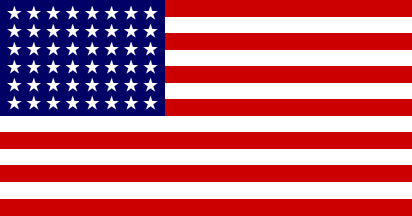Stars And Stripes Forever
I was just thinking about how this year contains the 60th anniversary of both Alaska and Hawaii being admitted to the union.
That makes 1959 a pretty big year for new states--Alaska in January and Hawaii in August. They were the first new states since New Mexico and Arizona in 1912. I'm sure Americans got pretty used to 48 states. And it makes for a nice looking flag, with the stars lined up six by eight.
So after two generations of 48 states, it must have been weird getting two more. (I wonder how many 47 and 49 star flags were sewn and out of date almost immediately?) And that's how it would seem now. We've gone three generations without any new states, and somehow 50 seems the exact right amount, even though it's arbitrary. (And a 51-star flag wouldn't be tough--three rows of nine mixed with three rows of eight.)
So we're living in an historical anomaly. Until the 1920s, there wasn't a single decade in American history when at least one new state wasn't admitted. Have we sort of settled down? No more destiny to manifest? Or is it just too much a political struggle to let in anyone new and upset the balance we've maintained?


3 Comments:
Greenland and The Far Side. Somehow that seems fitting.
In 1783, England and the USA signed a treaty giving the United States a big chunk of territory -- basically everything to the Mississippi River. The 13 colonies, plus lots of unclaimed land to the west!
Initially, the states started claiming this land for themselves. If these claims had stuck, Virginia would have been huge. But finally they agreed that this land to the west would be "the territories", and when Americans settled there, they could create new states.
Virginia agreed to this, because it had already begun to settle the territory to its west. So instead of expanding Virginia's boundaries, this settlement became "Kentucky" -- and between them they had four senators instead of two.
Meanwhile, in 1898 we had become a colonial empire, seizing Cuba, Puerto Rico, Hawaii, and the Philippines. These were not intended to become states, ever. And -- in a related point -- they were not intended primarily as places for Americans to settle and colonize; they were intended as sources of wealth and sea power. In other words, we viewed them as the British Empire viewed India, not as the British Empire viewed New Zealand.
Until the 1950s, 100% of our new states came from our continental territories, not from the disconnected territories.
But then in the 1950s, the anti-colonial movement swept the Third World. Owning colonies was suddenly embarrassing.
So we granted independence to the Philippines, and made Alaska and Hawaii states. We had already converted Cuba from a territory to an "independent" satellite state, although that ended in 1959.
And we made Puerto Rico into a quasi-state: it has its own governor and legislature, and a non-voting delegate in the U.S. Congress. The population there is split on whether they prefer statehood, independence, or the current status.
Puerto Rico might become a state someday. But our other remaining colonies are too tiny. Guam has 170,000 people, the Virgin Islands 107,000, Mariana Islands 52,000, and American Samoa 51,000.
So 51 is probably the limit.
Colonialism was definitely on the way out after WW2, but even during the war, FDR had a different view of empire from Churchill. Churchill wanted the British Empire to continue, while FDR believed most states should be free (if not free of influence from larger states).
Virginia also had a chunk split out of it which became a new state in the Civil War.
Post a Comment
<< Home